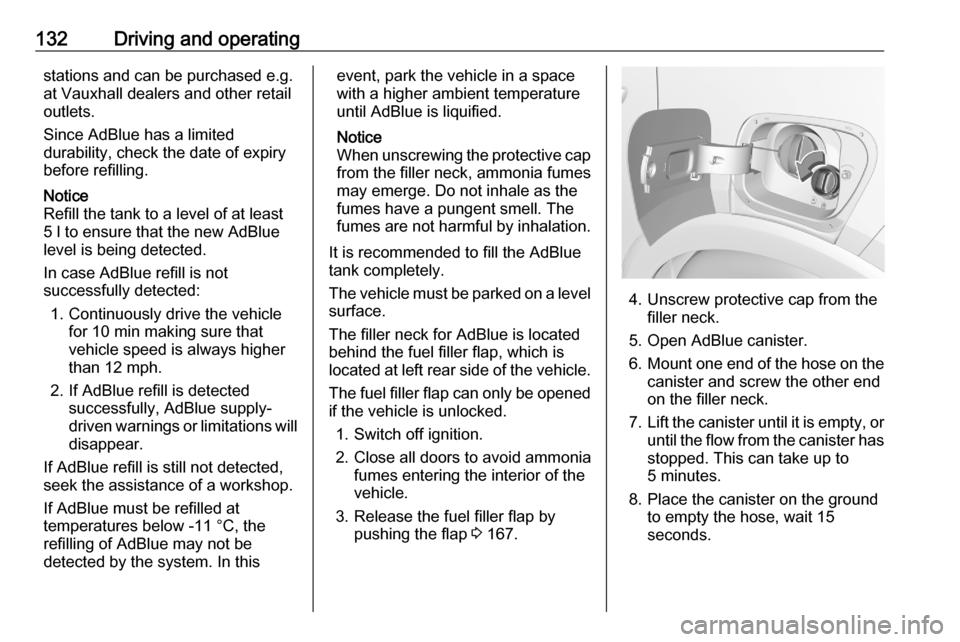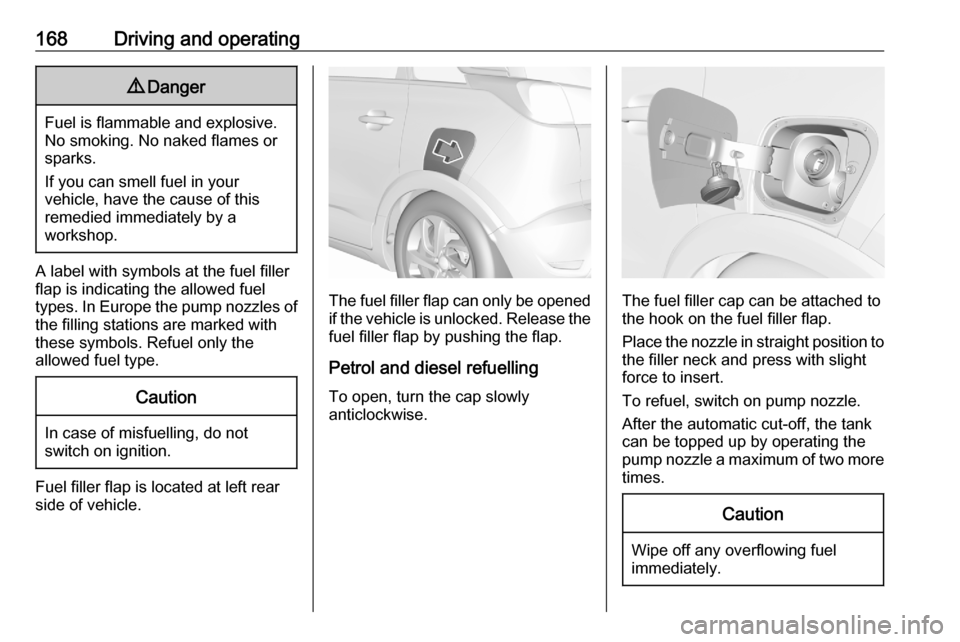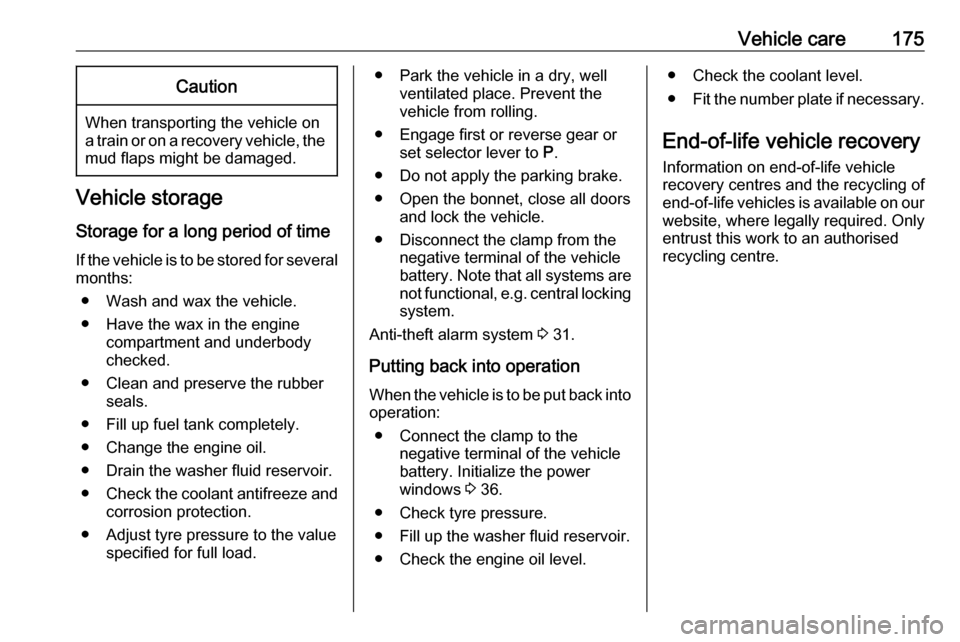Open fuel VAUXHALL CROSSLAND X 2020 User Guide
[x] Cancel search | Manufacturer: VAUXHALL, Model Year: 2020, Model line: CROSSLAND X, Model: VAUXHALL CROSSLAND X 2020Pages: 245, PDF Size: 21.85 MB
Page 134 of 245

132Driving and operatingstations and can be purchased e.g.
at Vauxhall dealers and other retail
outlets.
Since AdBlue has a limited
durability, check the date of expiry
before refilling.
Notice
Refill the tank to a level of at least
5 l to ensure that the new AdBlue
level is being detected.
In case AdBlue refill is not
successfully detected:
1. Continuously drive the vehicle for 10 min making sure that
vehicle speed is always higher
than 12 mph.
2. If AdBlue refill is detected successfully, AdBlue supply-
driven warnings or limitations will
disappear.
If AdBlue refill is still not detected,
seek the assistance of a workshop.
If AdBlue must be refilled at
temperatures below -11 °C, the
refilling of AdBlue may not be
detected by the system. In thisevent, park the vehicle in a space
with a higher ambient temperature
until AdBlue is liquified.
Notice
When unscrewing the protective cap from the filler neck, ammonia fumesmay emerge. Do not inhale as the
fumes have a pungent smell. The
fumes are not harmful by inhalation.
It is recommended to fill the AdBlue
tank completely.
The vehicle must be parked on a level surface.
The filler neck for AdBlue is located
behind the fuel filler flap, which is located at left rear side of the vehicle.
The fuel filler flap can only be opened
if the vehicle is unlocked.
1. Switch off ignition.
2. Close all doors to avoid ammonia fumes entering the interior of the
vehicle.
3. Release the fuel filler flap by pushing the flap 3 167.
4. Unscrew protective cap from the
filler neck.
5. Open AdBlue canister.
6. Mount one end of the hose on the
canister and screw the other end
on the filler neck.
7. Lift the canister until it is empty, or
until the flow from the canister has
stopped. This can take up to
5 minutes.
8. Place the canister on the ground to empty the hose, wait 15
seconds.
Page 170 of 245

168Driving and operating9Danger
Fuel is flammable and explosive.
No smoking. No naked flames or
sparks.
If you can smell fuel in your
vehicle, have the cause of this
remedied immediately by a
workshop.
A label with symbols at the fuel filler
flap is indicating the allowed fuel
types. In Europe the pump nozzles of the filling stations are marked with
these symbols. Refuel only the
allowed fuel type.
Caution
In case of misfuelling, do not
switch on ignition.
Fuel filler flap is located at left rear
side of vehicle.
The fuel filler flap can only be opened
if the vehicle is unlocked. Release the
fuel filler flap by pushing the flap.
Petrol and diesel refuelling To open, turn the cap slowly
anticlockwise.The fuel filler cap can be attached to
the hook on the fuel filler flap.
Place the nozzle in straight position to the filler neck and press with slight
force to insert.
To refuel, switch on pump nozzle.
After the automatic cut-off, the tank can be topped up by operating the
pump nozzle a maximum of two more
times.
Caution
Wipe off any overflowing fuel
immediately.
Page 171 of 245

Driving and operating169To close, turn the fuel filler cap
clockwise.
Close the flap and allow it to engage.
Fuel filler cap Only use genuine fuel filler caps.Diesel-engined vehicles have special
fuel filler caps.Trailer hitch
General information
Entrust retrofitting of towing
equipment to a workshop. It may be
necessary to make changes that
affect the cooling system, heat
shields or other equipment. Only use
approved towing equipment.
The bulb outage detection function for trailer or bike carrier brake light
cannot detect a partial bulb outage.
E.g. in case of four bulbs with a power
of 5 W each, the function only detects
light outage when only a single 5 W
light remains or none remain.
LED lights are not suitable for the
wiring harness of this trailer hitch.
Towing equipment could cover the
opening of the towing eye. If this is the case use the coupling ball bar for
towing.Driving characteristics and
towing tips
Before attaching a trailer, lubricate the coupling ball. However, do not do so if a stabiliser, which acts on thecoupling ball, is being used to reduce
snaking movements.
During trailer towing do not exceed a
speed of 50 mph. A maximum speed
of 60 mph is only appropriate if an
oscillation damper is used and the
permissible gross trailer weight does
not exceed the vehicle's curb weight.
For trailers with low driving stability
and caravan trailers, the use of an
oscillation damper is strongly
recommended.
If the trailer starts snaking, drive more slowly, do not attempt to correct the
steering and brake sharply if
necessary.
When driving downhill, drive in the
same gear as if driving uphill and
drive at a similar speed.
Adjust tyre pressure to the value
specified for full load 3 229.
Page 177 of 245

Vehicle care175Caution
When transporting the vehicle on
a train or on a recovery vehicle, the
mud flaps might be damaged.
Vehicle storage
Storage for a long period of time
If the vehicle is to be stored for several months:
● Wash and wax the vehicle.
● Have the wax in the engine compartment and underbody
checked.
● Clean and preserve the rubber seals.
● Fill up fuel tank completely.
● Change the engine oil.
● Drain the washer fluid reservoir.
● Check the coolant antifreeze and
corrosion protection.
● Adjust tyre pressure to the value specified for full load.
● Park the vehicle in a dry, wellventilated place. Prevent the
vehicle from rolling.
● Engage first or reverse gear or set selector lever to P.
● Do not apply the parking brake.
● Open the bonnet, close all doors and lock the vehicle.
● Disconnect the clamp from the negative terminal of the vehicle
battery. Note that all systems are
not functional, e.g. central locking system.
Anti-theft alarm system 3 31.
Putting back into operation
When the vehicle is to be put back into
operation:
● Connect the clamp to the negative terminal of the vehicle
battery. Initialize the power
windows 3 36.
● Check tyre pressure.
● Fill up the washer fluid reservoir.
● Check the engine oil level.● Check the coolant level.
● Fit the number plate if necessary.
End-of-life vehicle recovery
Information on end-of-life vehicle
recovery centres and the recycling of
end-of-life vehicles is available on our website, where legally required. Only
entrust this work to an authorised
recycling centre.
Page 241 of 245

239Control indicators.......................... 82
Control of the vehicle .................122
Controls ........................................ 70
Convex shape .............................. 33
Coolant and antifreeze ...............219
Cornering lights .......................... 104
Cruise control ...................... 88, 140
Cupholders .................................. 61
Curtain airbag system .................. 53
D Danger, Warnings and Cautions ...4
Daytime running lights ...............104
Declaration of conformity ............231
DEF ............................................ 130
Deflation detection system ...........86
Diesel exhaust fluid ....................130
Diesel fuel system bleeding .......181
Door open .................................... 88
Doors ............................................ 29
Driver alert .................................. 164
Driver assistance systems ..........140
Driver Information Centre .............89
Driving characteristics and towing tips .............................. 169
Driving hints ................................ 122
E Electric adjustment ......................33
Electrical system......................... 191
Electronic climate control system 114Electronic driving programmes ..135
Electronic key system ...................22
Electronic Stability Control and Traction Control system ....85, 139
Electronic Stability Control and Traction Control system off .......86
Emergency call ............................. 99
End-of-life vehicle recovery .......175
Engine compartment fuse box ...191
Engine coolant ........................... 178
Engine coolant temperature ........86
Engine coolant temperature gauge ....................................... 80
Engine data ............................... 225
Engine exhaust .......................... 129
Engine identification ...................222
Engine oil ...........177, 219, 223, 229
Engine oil level monitor ................81
Engine oil pressure ......................87
Entry lighting .............................. 108
Event data recorders ..................234
Exhaust filter ......................... 86, 129
Exit lighting ................................ 108
Exterior care .............................. 211
Exterior light ................................. 87
Exterior lighting ....................12, 101
Exterior mirrors ............................. 33F
Fault ........................................... 135
First aid ......................................... 66
First aid kit ................................... 66
Fixed air vents ........................... 119
Floor mats................................... 214
Folding mirrors ............................. 34
Forward collision alert................. 145
Front airbag system .....................52
Front fog lights .............88, 105, 185
Front pedestrian protection ........149
Front seats.................................... 41
Fuel............................................. 166
Fuel for diesel engines ..............166
Fuel for petrol engines ...............166
Fuel gauge ................................... 80 Fuel tank ..................................... 229
Fuses ......................................... 191
G
Gauges ......................................... 79
Gear selection ........................... 133
Gear shifting ................................. 85
General information ...................169
Glass panel .................................. 38
Glovebox ..................................... 61
H Halogen headlights ....................182
Hand brake ......................... 137, 138
Hazard warning flashers ............104